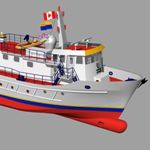BMT ‘Green’ Ship For The University Of Victoria
 BMT Fleet Technology, of Ottawa, Ontario has announced its collaboration with the University of Victoria to design and deliver North America’s first ever hybrid, electric research ship. The vessel, formerly known as CCG Tsekoa II, will be used by the University as a research facility off the British Columbia (BC) coast to investigate changing coastal ecosystems, marine resources and continental shelf and slope dynamics.
BMT Fleet Technology, of Ottawa, Ontario has announced its collaboration with the University of Victoria to design and deliver North America’s first ever hybrid, electric research ship. The vessel, formerly known as CCG Tsekoa II, will be used by the University as a research facility off the British Columbia (BC) coast to investigate changing coastal ecosystems, marine resources and continental shelf and slope dynamics.
The vessel which is currently 26.7 m long and 7.25 m wide at the beam will be cut in half and a new section will be inserted at mid-ship in order to bring the total length to 33 m. The new section will include a science lab and additional berths to accommodate 15 crew and scientists. Funding in excess of CAD 10 million has been provided by the Canada Foundation for Innovation, the BC Knowledge Development Fund and other partners, including industry.
Research Capabilities
Kim Juniper, lead scientist on the project comments: “As a national and international leader in the study of the oceans we are always looking to enhance our research capabilities. With the help of BMT Fleet Technology and its marine engineering expertise, this ship will enable us to perform acoustically sensitive studies in the ocean and on marine mammals, without the thundering noise of diesel engines.”
Green Fit
David Stocks, vice president – Pacific Region, BMT Fleet Technology explains: “We are very proud to be working alongside the University helping to deliver a ship which is not only fit for purpose, but also environmentally friendly. Through the application of green technology a reduction in carbon emissions will be achieved, as well as an enhancement in the ship’s fuel efficiency.”
An innovative leader in providing through-life engineering support, BMT Fleet Technology will align the new ship design with the University’s requirements, equipping the vessel with a hybrid-electric propulsion system powered by batteries, fuel cells and low-emission diesel generators.






